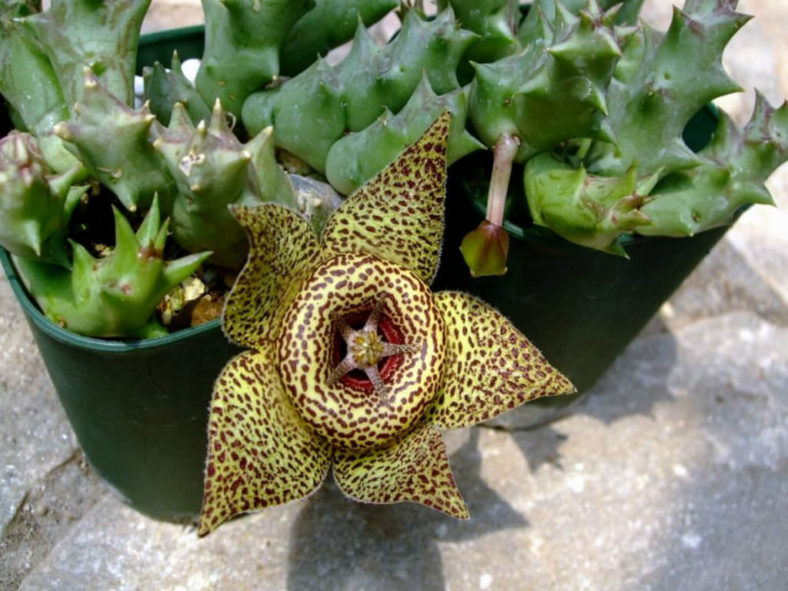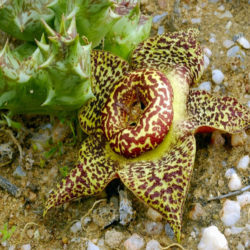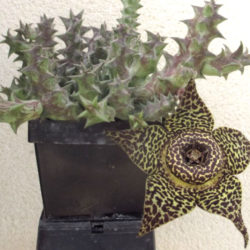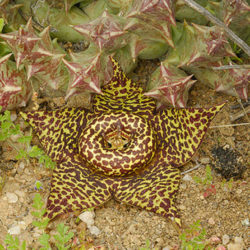Scientific Name
Orbea namaquensis (N.E.Br.) L.C.Leach
Common Name(s)
Namaqua Orbea
Synonym(s)
Ceropegia namaquana, Stapelia namaquensis
Scientific Classification
Family: Apocynaceae
Subfamily: Asclepiadoideae
Tribe: Ceropegieae
Subtribe: Stapeliinae
Genus: Orbea
Description
Orbea namaquensis is a low-growing succulent that forms a clump or dense mat of short stems with tubercles arranged into four rows along the stem, tapering into a stout conical tooth. Stems can grow up to 4 inches (10 cm) long and up to 1.6 inches (4 cm) thick (excluding teeth). They are green and beautifully marked with purple-brown when exposed to enough sunlight.
During the fall, the plant produces large, star-shaped flowers in the lower half of the stems, solitary or in clusters of 2 to 4, developing in gradual succession from a short stalk. The flowers are up to 4 inches (10 cm) in diameter. The corolla is pale greenish-yellow to bright yellow, variously spotted and lined with purple-brown, rugose on lobes and around the annulus, obscurely rugulose on the annulus, becoming smooth towards the center. The outer corona lobes are yellow dotted with purple-brown with larger purple-brown patches at the base, while the inner ones are yellow dotted with purple-brown.
Origin
Orbea namaquensis is native to South Africa. It has relatively restricted distribution in Namaqualand and is only known to the south of the Orange River, where it grows on gravelly slopes or loamy flats.

Hardiness
USDA hardiness zone 9b to 11b: from 25 °F (−3.9 °C) to 50 °F (+10 °C).
How to Grow and Care
Several species are fairly easy to grow. Others, often those with slightly hairy stems and the more unusual flowers, are more challenging and require careful watering (with some fertilizer) during the growing season and complete water withdrawal during the winter months. A minimum winter temperature of 10°C (50°F) is acceptable, providing that soil is kept dry. A heated growing bench or incubator may help delicate plants tet through the colder months. However, many species live under shrubs in their habitat and prefer light shade rather than full sun.
A gritty compost is essential, and clay pots are advisable for the more delicate species. Some growers prefer mineral-only compost to minimize the chance of a fungal attack on the roots. A layer of grit on the compost surface prevents moisture from accumulating around the base of the stems.
Keeping Stapelias and their roots free of pests such as mealybugs is the key to success, as fungal attacks often result from damage to stems by insects.
See more at How to Grow and Care for Stapelia.
Links
- Back to genus Orbea
- Succupedia: Browse succulents by Scientific Name, Common Name, Genus, Family, USDA Hardiness Zone, Origin, or cacti by Genus
Photo Gallery
Click on a photo to see a larger version.


